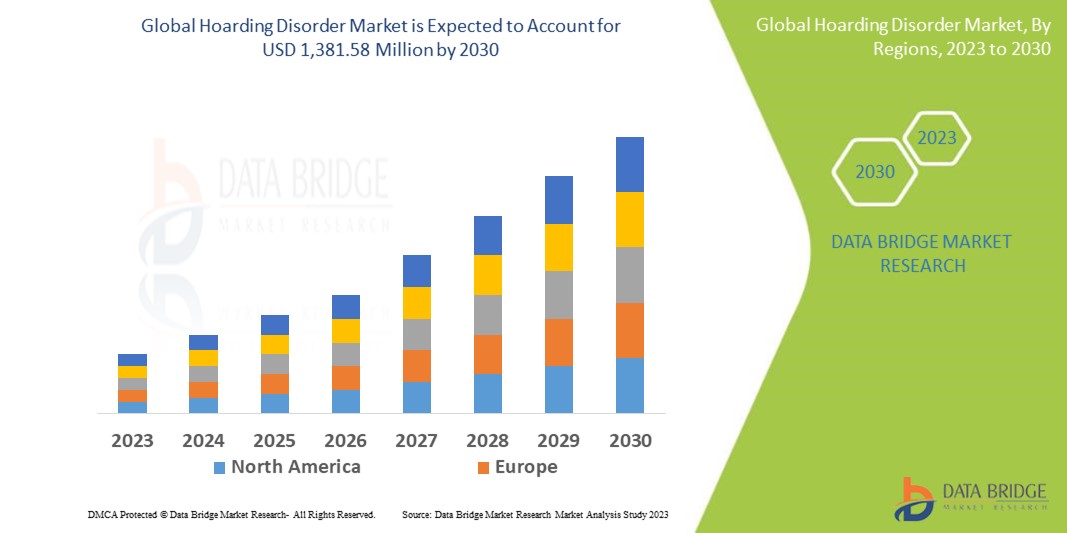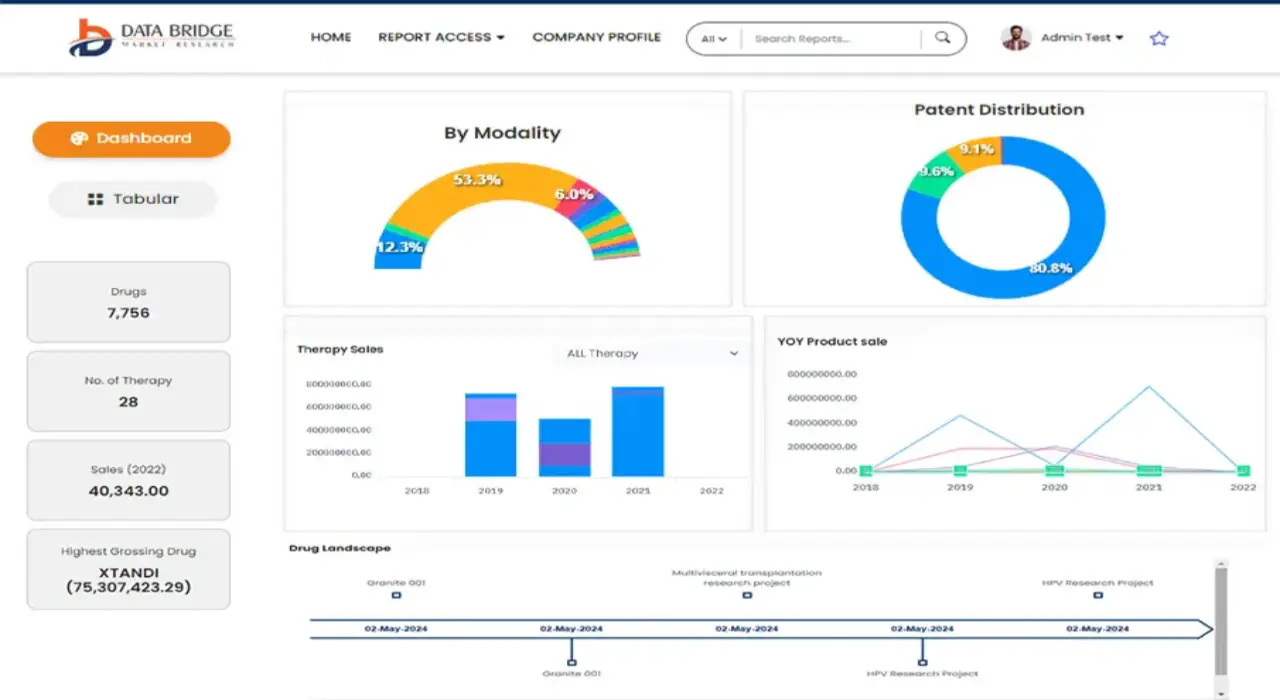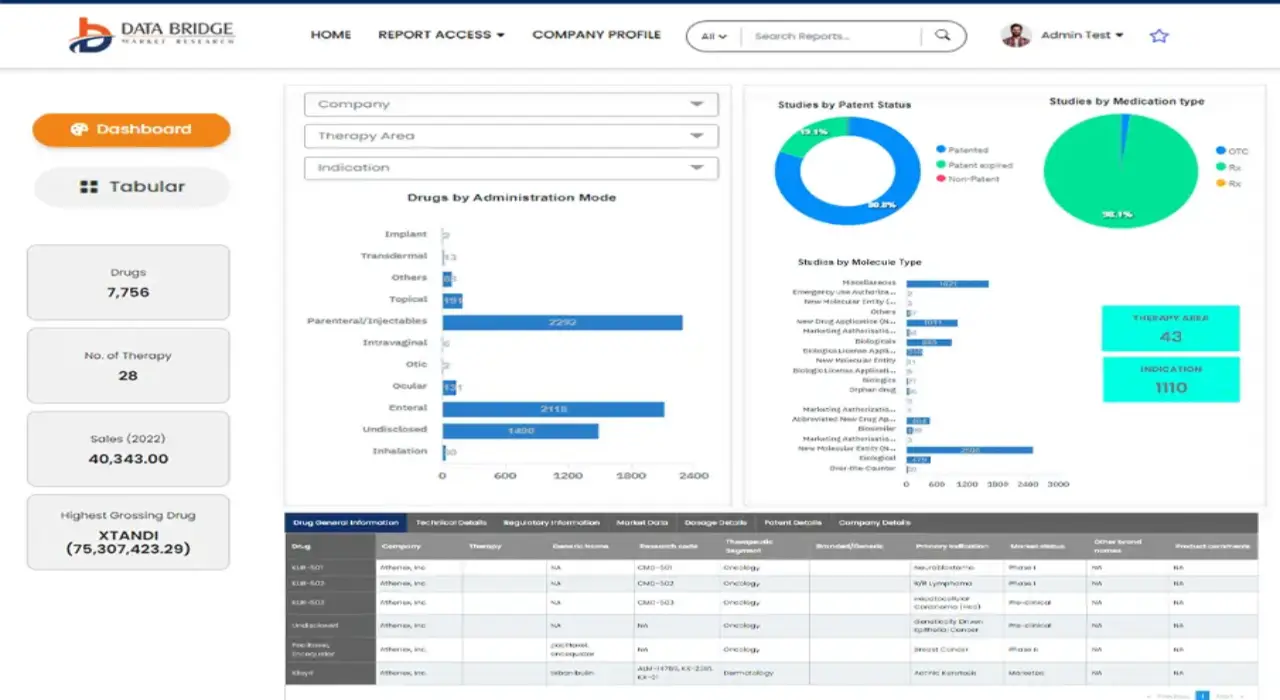Global Hoarding Disorder Market
Market Size in USD Million
CAGR :
% 
 USD
978.98 Million
USD
1,381.58 Million
2022
2030
USD
978.98 Million
USD
1,381.58 Million
2022
2030
| 2023 –2030 | |
| USD 978.98 Million | |
| USD 1,381.58 Million | |
|
|
|
|
Global Hoarding Disorder Market, By Treatment (Cognitive-Behavioral Therapy (CBT), Antidepressants, Others), Symptoms (Living in unusable spaces due to clutter, Inability to get rid of possessions, Anxiety about needing items in the future, Extreme stress about throwing out items, Distrust of others touching possessions, Uncertainty about where to put things, Withdrawing from friends and family, Others), Dosage (Tablet, Injection, Others), Route of Administration (Oral, Intravenous, Others), End-Users (Clinic, Hospital, Others), Distribution Channel (Hospital Pharmacy, Retail Pharmacy, Online Pharmacy) - Industry Trends and Forecast to 2030.
Hoarding Disorder Market Analysis and Size
A hoarding condition occurs when a person accumulates an excessive number of objects and keeps them in an unorganised manner, resulting in unmanageable clutter. It's possible that the items have little or no monetary worth. Hoarding disorders are difficult to cure because many hoarders are unaware that they have a problem or are unaware of how it affects their lives or the lives of others. This neurological disorder is characterised by living in unusable spaces due to clutter, inability to get rid of possessions, anxiety about needing items in the future, extreme stress about throwing out items, distrust of others touching possessions, uncertainty about where to put things, withdrawing from friends and family, among others.
Data Bridge Market Research analyses that the Hoarding Disorder market was valued at USD 978.98 million in 2022 and is expected to reach the value of USD 1,381.58 million by the year 2030, at a CAGR of 4.40% during the forecast period. This indicates that the market value. “Cognitive-Behavioral Therapy (CBT)” dominates the treatment segment of the hoarding disorder market owing to the increasing prevalence of cardiac arrhythmias. In addition to the insights on market scenarios such as market value, growth rate, segmentation, geographical coverage, and major players, the market reports curated by the Data Bridge Market Research also include depth expert analysis, patient epidemiology, pipeline analysis, pricing analysis, and regulatory framework.
Hoarding Disorder Market Scope and Segmentation
|
Report Metric |
Details |
|
Forecast Period |
2023 to 2030 |
|
Base Year |
2022 |
|
Historic Years |
2021 (Customizable to 2015-2020) |
|
Quantitative Units |
Revenue in USD Million, Volumes in Units, Pricing in USD |
|
Segments Covered |
Treatment (Cognitive-Behavioral Therapy (CBT), Antidepressants, Others), Symptoms (Living in unusable spaces due to clutter, Inability to get rid of possessions, Anxiety about needing items in the future, Extreme stress about throwing out items, Distrust of others touching possessions, Uncertainty about where to put things, Withdrawing from friends and family, Others), Dosage (Tablet, Injection, Others), Route of Administration (Oral, Intravenous, Others), End-Users (Clinic, Hospital, Others), Distribution Channel (Hospital Pharmacy, Retail Pharmacy, Online Pharmacy) |
|
Countries Covered |
U.S., Canada and Mexico in North America, Peru, Brazil, Argentina and Rest of South America as part of South America, Germany, Italy, U.K., France, Spain, Netherlands, Belgium, Switzerland, Turkey, Russia, Hungary, Lithuania, Austria, Ireland, Norway, Poland, Rest of Europe in Europe, Japan, China, India, South Korea, Australia, Singapore, Malaysia, Thailand, Indonesia, Philippines, Vietnam, Rest of Asia-Pacific (APAC) in Asia-Pacific (APAC), South Africa, Saudi Arabia, U.A.E, Kuwait, Israel, Egypt, Rest of Middle East and Africa (MEA) as a part of Middle East and Africa (MEA). |
|
Market Players Covered |
F. Hoffmann-La Roche Ltd. (Switzerland), Mylan N.V. (US), Teva Pharmaceutical Industries Ltd.(Israel), Sanofi (France), Pfizer Inc. (US), GlaxoSmithKline plc (UK), Novartis AG (Switzerland), AstraZeneca (UK), Johnson & Johnson (US), Bayer AG (Germany), Sun Pharmaceutical Industries Ltd. (India), Eli Lilly and Company (US), Edenbridge Pharmaceuticals, LLC (US), ParaPRO LLC (US), Encube Ethicals (India), GALDERMA (Switzerland), Alliance Pharmaceuticals (UK), Foamix Pharmaceuticals Ltd (US), Arbor Pharmaceuticals (US), Dr. Reddy's Laboratories Ltd. (India), Perrigo Company plc (Ireland).among others. |
|
Market Opportunities |
|
Market Definition
Hoarding disorder market refers to the market for products, therapies, and services aimed at addressing the symptoms and challenges associated with hoarding disorder. It includes medications, counseling, professional organizing services, and other interventions designed to assist individuals in managing and reducing hoarding behaviors.
Global Hoarding Disorder Market Dynamics
Drivers
- Increased Awareness and Understanding of Hoarding Disorder
Growing awareness among the general public, healthcare professionals, and mental health organizations about hoarding disorder contributes to increased recognition and diagnosis of the condition, driving the demand for appropriate interventions.
- Rising Prevalence of the Disorder
Hoarding disorder is being increasingly recognized as a distinct mental health condition, with prevalence rates estimated to be higher than previously thought. The rising prevalence fuels the demand for interventions and treatment options.
- Advancements in Therapeutic Approaches
Ongoing research and advancements in therapeutic approaches, such as cognitive-behavioral therapy (CBT), motivational interviewing, and harm reduction strategies, offer promising options for the treatment of hoarding disorder, stimulating market growth.
Opportunities
The government initiatives, schemes, or funding that support and promotes the innovation and development of the Hoarding Disorder market provide growth opportunities for the market players in the forecast period of 2023 to 2030. Additionally, the Development of Innovative and Personalized Treatment approaches, collaborations between healthcare professionals and mental health organizations, penetration rate, market expansion in developing countries, and increasing per capita expenditure on healthcare will further expand the market's growth rate in the future.
Restraints
Limited Access to Specialized Care
Access to specialized care for hoarding disorder, including mental health professionals with expertise in hoarding behavior, may be limited in certain regions or healthcare systems. This can hinder timely and appropriate treatment.
Challenges
Lack of Standardized Diagnostic Criteria and Treatment Guidelines
The absence of universally accepted diagnostic criteria and treatment guidelines for hoarding disorder can lead to variations in diagnosis and treatment approaches, posing challenges in ensuring consistent and effective care. Also, co-occurring mental health conditions, challenges in engaging and sustaining individuals in treatment, and lack of suitable infrastructure in low- and middle-income countries are projected to challenge the market in the forecast period of 2023-2030.
This hoarding disorder market report provides details of new recent developments, trade regulations, import-export analysis, production analysis, value chain optimization, market share, the impact of domestic and localized market players, analyses opportunities in terms of emerging revenue pockets, changes in market regulations, strategic market growth analysis, market size, category market growths, application niches and dominance, product approvals, product launches, geographic expansions, technological innovations in the market. To gain more info on the Hoarding Disorder market contact Data Bridge Market Research for an Analyst Brief, our team will help you take an informed market decision to achieve market growth.
Recent Development
- In June 2023, The Recovery Village estimated that hoarding affects 1 in every 50 people, but it may impact as many as 1 in every 20. According to the National Alliance on Mental Illness (NAMI), Massachusetts, up to 5 percent of the world’s population displays symptoms of clinically-diagnosable hoarding.
Global Hoarding Disorder Market Scope
The hoarding disorder market is segmented on the basis of treatment, symptoms, dosage, route of administration, end-users and distribution channel. The growth amongst these segments will help you analyse meagre growth segments in the industries and provide the users with a valuable market overview and market insights to help them make strategic decisions for identifying core market applications.
Treatment
- Cognitive-Behavioral Therapy (CBT)
- Antidepressants
- Others
Symptoms
- Living in unusable spaces due to clutter
- Inability to get rid of possessions
- Anxiety about needing items in the future
- Extreme stress about throwing out items
- Distrust of others touching possessions
- Uncertainty about where to put things
- Withdrawing from friends and family
- Others
Dosage
- Tablet
- Injection
- Others
Route of Administration
- Oral
- Intravenous
- Others
End-Users
- Clinic
- Hospital
- Others
Distribution Channel
- Hospital Pharmacy
- Retail Pharmacy
- Online Pharmacy
Global Hoarding Disorder Market Regional Analysis/Insights
The hoarding disorder market is analysed, and market size insights and trends are provided by country, treatment, symptoms, dosage, route of administration, end-users and distribution channel as referenced above.
The countries covered in the hoarding disorder market report are U.S., Canada and Mexico in North America, Peru, Brazil, Argentina and Rest of South America as part of South America, Germany, Italy, U.K., France, Spain, Netherlands, Belgium, Switzerland, Turkey, Russia, Hungary, Lithuania, Austria, Ireland, Norway, Poland, Rest of Europe in Europe, Japan, China, India, South Korea, Australia, Singapore, Malaysia, Thailand, Indonesia, Philippines, Vietnam, Rest of Asia-Pacific (APAC) in Asia-Pacific (APAC), South Africa, Saudi Arabia, U.A.E, Kuwait, Israel, Egypt, Rest of Middle East and Africa (MEA) as a part of Middle East and Africa (MEA).
North America dominates the hoarding disorder market due to the presence of major key players, high healthcare expenditure and well-developed healthcare infrastructure in this region.
Asia-Pacific is expected to witness significant growth during the forecast period of 2023 to 2030 due to the increasing research and development activities, rising investment in the healthcare sector and growing government support in this region.
The country section of the report also provides individual market impacting factors and changes in regulation in the market domestically that impacts the current and future trends of the market. Data points like down-stream and upstream value chain analysis, technical trends and porter's five forces analysis, and case studies are some of the pointers used to forecast the market scenario for individual countries. Also, the presence and availability of global brands and their challenges faced due to large or scarce competition from local and domestic brands, the impact of domestic tariffs and trade routes are considered while providing forecast analysis of the country data.
Healthcare Infrastructure Growth Installed Base and New Technology Penetration
The hoarding disorder market also provides you with a detailed market analysis for every country's growth in healthcare expenditure for capital equipment, installed base of different kinds of products for the hoarding disorder market, the impact of technology using lifeline curves and changes in healthcare regulatory scenarios and their impact on the Hoarding Disorder market. The data is available for the historic period 2010-2020.
Competitive Landscape and Global Hoarding Disorder Market Share Analysis
The hoarding disorder market competitive landscape provides details by competitors. Details included are company overview, company financials, revenue generated, market potential, investment in research and development, new market initiatives, global presence, production sites and facilities, production capacities, company strengths and weaknesses, product launch, product width and breadth, application dominance. The above data points provided are only related to the companies' focus related to the hoarding disorder market.
Some of the major players operating in the hoarding disorder market are:
- F. Hoffmann-La Roche Ltd. (Switzerland)
- Mylan N.V. (US)
- Teva Pharmaceutical Industries Ltd.(Israel)
- Sanofi (France),
- Pfizer Inc. (US)
- GlaxoSmithKline plc (UK)
- Novartis AG (Switzerland)
- AstraZeneca (UK)
- Johnson & Johnson (US)
- Bayer AG (Germany)
- Sun Pharmaceutical Industries Ltd. (India)
- Eli Lilly and Company (US)
- Edenbridge Pharmaceuticals, LLC (US)
- ParaPRO LLC (US)
- Encube Ethicals (India)
- GALDERMA (Switzerland)
- Alliance Pharmaceuticals (UK)
- Foamix Pharmaceuticals Ltd (US)
- Arbor Pharmaceuticals (US)
- Dr. Reddy's Laboratories Ltd. (India)
- Perrigo Company plc (Ireland)
SKU-
Get online access to the report on the World's First Market Intelligence Cloud
- Interactive Data Analysis Dashboard
- Company Analysis Dashboard for high growth potential opportunities
- Research Analyst Access for customization & queries
- Competitor Analysis with Interactive dashboard
- Latest News, Updates & Trend analysis
- Harness the Power of Benchmark Analysis for Comprehensive Competitor Tracking
Research Methodology
Data collection and base year analysis are done using data collection modules with large sample sizes. The stage includes obtaining market information or related data through various sources and strategies. It includes examining and planning all the data acquired from the past in advance. It likewise envelops the examination of information inconsistencies seen across different information sources. The market data is analysed and estimated using market statistical and coherent models. Also, market share analysis and key trend analysis are the major success factors in the market report. To know more, please request an analyst call or drop down your inquiry.
The key research methodology used by DBMR research team is data triangulation which involves data mining, analysis of the impact of data variables on the market and primary (industry expert) validation. Data models include Vendor Positioning Grid, Market Time Line Analysis, Market Overview and Guide, Company Positioning Grid, Patent Analysis, Pricing Analysis, Company Market Share Analysis, Standards of Measurement, Global versus Regional and Vendor Share Analysis. To know more about the research methodology, drop in an inquiry to speak to our industry experts.
Customization Available
Data Bridge Market Research is a leader in advanced formative research. We take pride in servicing our existing and new customers with data and analysis that match and suits their goal. The report can be customized to include price trend analysis of target brands understanding the market for additional countries (ask for the list of countries), clinical trial results data, literature review, refurbished market and product base analysis. Market analysis of target competitors can be analyzed from technology-based analysis to market portfolio strategies. We can add as many competitors that you require data about in the format and data style you are looking for. Our team of analysts can also provide you data in crude raw excel files pivot tables (Fact book) or can assist you in creating presentations from the data sets available in the report.













